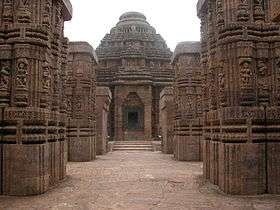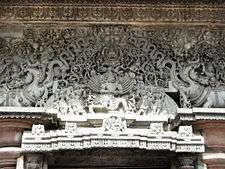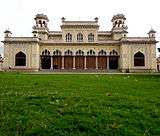Architecture of India
| Part of a series on the |
| Culture of India |
|---|
 |
| History |
| People |
| Cuisine |
| Religion |
|
Music and performing arts |
| Sport |
|
The architecture of India is rooted in its history, culture and religion. Indian architecture progressed with time and assimilated the many influences that came as a result of India's global discourse with other regions of the world throughout its millennia-old past. The architectural methods practiced in India are a result of examination and implementation of its established building traditions and outside cultural interactions.[1]
Though old, this Eastern tradition has also incorporated modern values as India became a modern nation state. The economic reforms of 1991 further bolstered the urban architecture of India as the country became more integrated with the world's economy. Traditional Vastu Shastra remains influential in India's architecture during the contemporary era.[1]
Indus Valley Civilization (3300 BC—1700BC)
|
|
The Indus Valley Civilization (IVC) was a Bronze Age civilization (3300–1700 BC; mature period 2600–1900 BC) that was located in the northwestern region of the Indian subcontinent, consisting of what is now mainly modern-day Pakistan and northwest India. Flourishing around the Indus River basin, the civilization primarily centred along the Indus and the Punjab region, extending into the Ghaggar-Hakra River valley and the Ganges-Yamuna Doab. Geographically, the civilization was spread over an area of some 1,260,000 square km, making it the largest ancient civilization in the world.
The Indus Valley is one of the world's earliest urban civilizations, along with its contemporaries, Mesopotamia and Ancient Egypt. At its peak, the Indus Civilization may have had a population of well over five million. Inhabitants of the ancient Indus river valley developed new techniques in metallurgy and handicraft (carneol products, seal carving) and produced copper, bronze, lead, and tin. The civilization is noted for its cities built of brick, roadside drainage system, and multistoried houses. The baths and toilets system the cities had is acknowledged as one of the most advanced in the ancient world. The grid layout planning of the cities with roads at exact right angles is a modern system that was implemented in the cities of this particular civilization. The urban agglomeration and production scale of this particular civilization was unsurpassed at the time and for many future centuries.
The mature phase of this civilization is called the Harappan Civilization, as the first of its cities to be unearthed was located at Harappa, excavated in the 1920s in what was at the time the Punjab province of British India (now in Pakistan). Excavation of Harappan sites have been ongoing since 1920, with important breakthroughs occurring as recently as 1999. To date, over 1,052 cities and settlements have been found, mainly in the general region of the Ghaggar-Hakra river and its tributaries. Among the settlements were the major urban centres of Harappa, Lothal, Mohenjo-daro (UNESCO World Heritage Site), Dholavira, Kalibanga, and Rakhigarhi.
Post Maha Janapadas period (600 BC—200 AD)
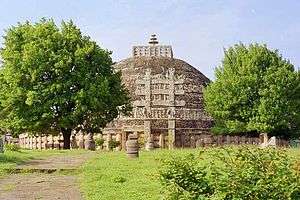
The Buddhist stupa, a dome shaped monument, was used in India as a commemorative monument associated with storing sacred relics.[2] The stupa architecture was adopted in Southeast and East Asia, where it became prominent as a Buddhist monument used for enshrining sacred relics.[2] Fortified cities with stūpas, viharas, and temples were constructed during the Maurya empire (c. 321–185 BC).[3] Wooden architecture was popular and rock cut architecture became solidified.[3] Guard rails—consisting of posts, crossbars, and a coping—became a feature of safety surrounding a stupa.[3] Temples—build on elliptical, circular, quadrilateral, or apsidal plans—were constructed using brick and timber.[3] The Indian gateway arches, the torana, reached East Asia with the spread of Buddhism.[4] Some scholars hold that torii derives from the torana gates at the Buddhist historic site of Sanchi (3rd century BC – 11th century AD).[5]
Rock-cut stepwells in India date from 200–400 AD.[6] Subsequently, the construction of wells at Dhank (550–625 AD) and stepped ponds at Bhinmal (850–950 AD) took place.[6] The city of Mohenjo-daro has wells which may be the predecessors of the step well.[7] As many as 700 wells, constructed by 3rd millennium BC, have been discovered in just one section of the city, leading scholars to believe that 'cylindrical brick lined wells' were invented by the people of the Indus Valley Civilization.[7] Cave temples became prominent throughout western India, incorporating various unique features to give rise to cave architecture in places such as Ajanta and Ellora.[3]
Walled and moated cities with large gates and multi-storied buildings which consistently used arched windows and doors are important features of the architecture during this period.[3] The Indian emperor Ashoka (rule: 273—232 BC) established a chain of hospitals throughout the Mauryan empire by 230 BCE.[8] One of the edicts of Ashoka (272—231 BC) reads: "Everywhere King Piyadasi (Ashoka) erected two kinds of hospitals, hospitals for people and hospitals for animals. Where there were no healing herbs for people and animals, he ordered that they be bought and planted."[9] Indian art and culture has absorbed extraneous impacts by varying degrees, and is much richer for this exposure. This cross fertilization between different art streams converging on the subcontinent produced new forms that, while retaining the essence of the past, succeeded in the integrating selected elements of the new influences. A long tradition of art and culture was already established well before the beginning of 20th century in India. Indian painting can be broadly divided into two categories—MURALS and MINIATURE.
Early Common Era—High Middle Ages (200 AD—1200 AD)
Nalanda and Valabhi university housing thousands of teachers and students—flourished between the 4th–8th centuries.[10] South Indian temple architecture—visible as a distinct tradition during the 7th century AD[11]
|
|
|
Māru-Gurjara temple architecture originated somewhere in sixth century in and around areas of Rajasthan. Māru-Gurjara Architecture show the deep understanding of structures and refined skills of Rajasthani craftmen of bygone era. Māru-Gurjara Architecture has two prominent styles Maha-Maru and Maru-Gurjara. According to M. A. Dhaky, Maha-Maru style developed primarily in Marudesa, Sapadalaksha, Surasena and parts of Uparamala whereas Maru-Gurjara originated in Medapata, Gurjaradesa-Arbuda, Gurjaradesa-Anarta and some areas of Gujarat.[12] Scholars such as George Michell, M.A. Dhaky, Michael W. Meister and U.S. Moorti believe that Māru-Gurjara Temple Architecture is entirely Western Indian architecture and is quite different from the North Indian Temple architecture.[13] There is a connecting link between Māru-Gurjara Architecture and Hoysala Temple Architecture. In both of these styles architecture is treated sculpturally.[14]
The South Indian temple consists essentially of a square-chambered sanctuary topped by a superstructure, tower, or spire and an attached pillared porch or hall (maṇḍapa, or maṇṭapam), enclosed by a peristyle of cells within a rectangular court. The external walls of the temple are segmented by pilasters and carry niches housing sculpture. The superstructure or tower above the sanctuary is of the kūṭina type and consists of an arrangement of gradually receding stories in a pyramidal shape. Each story is delineated by a parapet of miniature shrines, square at the corners and rectangular with barrel-vault roofs at the centre. The tower is topped by a dome-shaped cupola and a crowning pot
North Indian temples showed increased elevation of the wall and elaborate spire by the 10th century.[15] Richly decorated temples—including the complex at Khajuraho—were constructed in Central India.[15] Indian traders brought Indian architecture to South east Asia through various trade routes.[16] Grandeur of construction, beautiful sculptures, delicate carvings, high domes, gopuras and extensive courtyards were the features of temple architecture in India. Examples include the Lingaraj Temple at Bhubaneshwar in Odisha, Sun Temple at Konark in Odisha, Brihadeeswarar Temple at Thanjavur in Tamil Nadu.
Late Middle Ages (1100 AD—1526 AD)
Vijayanagara Architecture of the period (1336 – 1565 AD) was a notable building style evolved by the Vijayanagar empire that ruled most of South India from their capital at Vijayanagara on the banks of the Tungabhadra River in present-day Karnataka.[17] The architecture of the temples built during the reign of the Vijayanagara empire had elements of political authority.[18] This resulted in the creation of a distinctive imperial style of architecture which featured prominently not only in temples but also in administrative structures across the deccan.[19] The Vijayanagara style is a combination of the Chalukya, Hoysala, Pandya and Chola styles which evolved earlier in the centuries when these empires ruled and is characterised by a return to the simplistic and serene art of the past.[20]
Hoysala architecture is the distinctive building style developed under the rule of the Hoysala Empire in the region historically known as Karnata, today's Karnataka, India, between the 11th and the 14th centuries.[21] Large and small temples built during this era remain as examples of the Hoysala architectural style, including the Chennakesava Temple at Belur, the Hoysaleswara Temple at Halebidu, and the Kesava Temple at Somanathapura. Other examples of fine Hoysala craftmanship are the temples at Belavadi, Amrithapura, and Nuggehalli. Study of the Hoysala architectural style has revealed a negligible Indo-Aryan influence while the impact of Southern Indian style is more distinct.[22] A feature of Hoysala temple architecture is its attention to detail and skilled craftmanship. The temples of Belur and Halebidu are proposed UNESCO world heritage sites.[23] About a 100 Hoysala temples survive today.[24]
Early Modern period (1500 AD—1947 AD)
Indo-Islamic Architecture
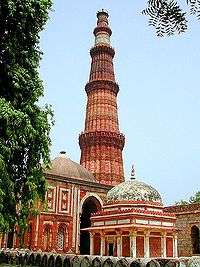

Mughal tombs of sandstone and marble show Persian influence.[25] The Red Fort at Agra (1565–74) and the walled city of Fatehpur Sikri (1569–74) are among the architectural achievements of this time—as is the Taj Mahal, built as a tomb for Queen Mumtaz Mahal by Shah Jahan (1628–58).[25] Employing the double dome, the recessed archwaywever, the depiction of any animal or human—an essential part of the Indian tradition—was forbidden in places of worship under Islam. The Taj Mahal does contain tilework of plant ornaments.[1] The architecture during the Mughal Period, with its rulers being of Turco-Mongol origin, has shown a notable blend of Indian style combined with the Islamic.
Some scholars hold that cultural contact with Europe under Manuel I of Portugal (reign: 25 October 1495—13 December 1521) resulted in exchange of architectural influences.[26] Little literary evidence exists to confirm the Indian influence but some scholars have nonetheless suggested a possible relation based on proximity of architectural styles.[26]
Taj Mahal in Agra, India is one of the wonders of the world. Taj Mahal is a symbol of love for some, and barbaric brutality to others due to the treatment meted out to the artisans who built it.
Maratha Architecture
The Marathas ruled over most of Maharashtra from the mid-17th to the early 19th centuries. Their religious 20 activity took full shape and soon the skyline of Maharashtrian towns was dominated by the rising temple spires. Old forms returned with this 'renewal' of Hindu architecture, infused by Sultanate and later the Mughal tradition. The architecture of Maratha period was planned with courtyards suited to tropical climates. The Maratha Architecture is known for its simplicity, visible logic & austere aesthetic, made rich by beautiful detailing, rhythm and repetition. The aisles and arcades, punctured by delicate niches, doors & windows create space in which the articulation of open, semi-open & covered areas is effortless and enchanting. The materials used during those times for construction were –
- Thin bricks
- Lime mortar
- Lime plaster
- Wooden columns
- Stone bases
- Basalt stone flooring
- Brick pavements
Maharashtra is famous for its caves and rock cut architectures. It is said that the varieties found in Maharashtra are wider than the caves and rock cut architectures found in the rock cut areas of Egypt, Assyria, Persia and Greece. The Buddhist monks first started these caves in the 2nd century BC, in search of serene and peaceful environment for meditation, and they found these caves on the hillsides.
Sikh Architecture
Sikh Architecture is a style of architecture that is characterized with values of progressiveness, exquisite intricacy, austere beauty and logical flowing lines. Due to its progressive style, it is constantly evolving into many newly developing branches with new contemporary styles. Although Sikh architecture was initially developed within Sikhism its style has been used in many non-religious buildings due to its beauty. 300 years ago, Sikh architecture was distinguished for its many curves and straight lines; Shri Keshgarh Sahib and the Sri Harmandir Sahib (Golden Temple) are prime examples.
European colonial architecture
As with the Mughals, under European colonial rule, architecture became an emblem of power, designed to endorse the occupying power. Numerous European countries invaded India and created architectural styles reflective of their ancestral and adopted homes. The European colonizers created architecture that symbolized their mission of conquest, dedicated to the state or religion.[27]
The British, French, Dutch and the Portuguese were the main European powers that colonized parts of India.[28] [29]
British Colonial Era: 1615 to 1947
The British arrived in 1615 and over the centuries, gradually overthrew the Maratha and Sikh empires and other small independent kingdoms. Britain was present in India for over three hundred years and their legacy still remains through some building and infrastructure that exist in their former colonies.[30]
The major cities colonized during this period were Madras, Calcutta, Bombay, Delhi, Agra, Bankipore, Karachi, Nagpur, Bhopal and Hyderabad.[31][29]
St Andrews Kirk, Madras is known for its colonial architecture. The building is circular in form and is sided by two rectangular sections one is the entrance porch. The entrance is lined with twelve colonnades and two British lions and motto of East India Company engraved on them. The interior holds sixteen columns and the dome is painted blue with decorated with gold stars.[32]
The staple of Madras was Fort St. George, a walled squared building adjacent to the beach. Surrounding the fort was White Town settlement of British and Indian area Black Town later to be called Georgetown.
Black Town described in 1855 as "the minor streets, occupied by the natives are numerous, irregular and of various dimensions. Many of them are extremely narrow and ill-ventilated ... a hallow square, the rooms opening into a courtyard in the centre."[33]
Garden houses were originally used as weekend houses for recreational use by the upper class British. Nonetheless, the garden house became ideal a full-time dwelling, deserting the fort in the 19th Century.[34]
Calcutta – Madras and Calcutta were similar bordered by water and division of Indian in the north and British in the south. An Englishwoman noted in 1750 "the banks of the river are as one may say absolutely studded with elegant mansions called here as at Madras, garden houses." Esplanade-row is fronts the fort with lined palaces.[35][36]
Indian villages in these areas consisted of clay and straw houses, later transformed into a metropolis of brick and stone.[37]
The Victoria Memorial in Calcutta, is the most effective symbolism of British Empire, built as a monument in tribute to Queen Victoria’s reign. The plan of the building consists of one large central part covered with a larger dome. Colonnades separate the two chambers. Each corner holds a smaller dome and is floored with marble plinth. The memorial stands on 26 hectares of garden surrounded by reflective pools.[38]
French: 1673 to 1954
The French colonized a fishing village (Pondicherry) in Tamil Nadu and transformed it into a flourishing port-town. The town was built on the French grid pattern and features neat sectors and perpendicular streets and divided into two sectors, French Quarter (Ville Blanche) and the Indian quarter (Ville Noire). French styled villas were styled with long compounds and stately walls, lined houses with verandas, large French doors and grills. Infrastructure such as banks, police station and Pondicherry International Port still hold the French presence.
To preserve Pondicherry an organization named INTACH was formed. Authorization is needed from INTACH, to annihilate any original French Architecture.[39]
French expanded their empire by colonizing coastal towns, Yanam in Andhra Pradesh, Karaikal in Tamil Nadu and Mahe in Kerala with a French atmosphere of quiet towns around beaches. French spelling on signage and traffic signs still remains.[29]
Dutch: 1605 to 1825
The Dutch entered India with the only interests of Trade in the early 17th Century. During their 200 years in India, they colonized Surat, Bharuch, Venrula, Ahmedabad, Malabar Coast, Kochi and Sadras.[29]
Surat – a Dutch factory in 1630’s Bharuch: Trading Post of the Dutch East India Company had a Dutch cemetery. Venrula: a warehouse was built for 3000 Guilders by Leendart Janszoons and a castle for the protection of the Dutch. Ahmedabad: The Dutch cemetery lies on the bank of Kankaria lake. It holds a mix of Indian and European styled graves, with domed tombs, pyramids, walled and plain grave stones. Malabar Coast Kochi: The Dutch Palace (Mattancherry Palace) – The palace was originally built by the Portuguese, it fell into the hands of the Dutch when the Portuguese lost control of Kochi. Dutch cemetery – The cemetery runs parallel to the beach and is the oldest European cemetery in India. It holds 104 tombs that visually narrate the Dutch influence in Architecture during the era. The cemetery is guarded by heavy walls and the entrance pillar still carries the original calligraphic inscription "1724" David Hall – which was the residence of the famous Dutch Commander and Governor of Kochi, Adriaan van Reed lot Drakestein was built in 1695. The hall has been restored as a cultural centre and art café for young, visual and performing artists. Bastion bungalow – This Dutch styled building near the Fort Kochi beach was built to protect the harbor. Thakur House – the Dutch built this bungalow overlooking the sea as a club. Sadras – 17 km (11 mi) from the rock cut temples of Mamallapuram is another Dutch settlement. Pullicat – Pullicat lake 55 km north of Madras is a million years old and the second largest lagoon in India. It was the most important trading post of the Dutch. They built two cemeteries. One was ruined due to negligence and at the entrance is flanked by stone pillars, having 76 tombs. Images of skeletons are carved onto the gravestones, symbolizing life and death.[40]
Portuguese: 1498 to 1961
The Portuguese arrived as merchants in the 1498 and were more driven by a Catholic missionary zeal than gaining powers in India. The Portuguese gained a foothold in Goa and ruled for 400 years[29] before being defeated and evicted by Operation Vijay.
Portuguese presence in Goa still remains evident. Colonizers' missionary spirit built many cathedrals, churches, basilicas and seminaries. The Basilica of Bom Jesus (Good Jesus), Old Goa, former capital during the Portuguese rule. The three storied Renaissance styled church was built of plaster and laterite in 1605, and holds the mortal remains of St. Francis Xavier. The interior is built in a Mosaic-Corinthian style and adorned with wood and gold leaf. The walls embrace old painting of saints as the floor is laid with pure white marble.[41]
The Portuguese – Catholic houses faced the street with unique large ornamental windows opening onto verandahs. Bold colours were painted on houses constructing distinct identity, allowing the sailors to recognize their houses from sea. The covered porches and verandas were designed for socializing contrary to the Hindu styled housing. Front doors were lined with columns, and railings were popular in embellishment.[42]
The interior of Goan-Portuguese houses consisted of elaborate patterns created with tiles imported from Europe and a false ceiling installed of wood. The walls are painted with bright colours contrasting to the earthy coloured furniture.
The walls were made out of mud or laterite stone and coloured with vegetable and natural dyes. Gateposts and compound walls were carved with great detail.[43]
Republic of India (1947 AD—present)

In recent times there has been a movement of population from rural areas to urban centres of industry, leading to price rise in property in various cities of India.[44] Urban housing in India balances space constrictions and is aimed to serve the working class.[45] Growing awareness of ecology has influenced architecture in India during modern times.[46]
Climate responsive architecture has long been a feature of India's architecture but has been losing its significance as of late.[47] Indian architecture reflects its various socio-cultural sensibilities which vary from region to region.[47] Certain areas are traditionally held to be belonging to women.[47] Villages in India have features such as courtyards, loggias, terraces and balconies.[45] Calico, chintz, and palampore—of Indian origin—highlight the assimilation of Indian textiles in global interior design.[48] Roshandans, which are skylights-cum-ventilators, are a common feature in Indian homes, especially in North India.[49][50]
Gallery
-
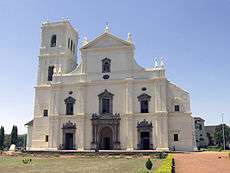
The Se Cathedral—located in Old Goa—is a cathedral dedicated to Catherine of Alexandria.
-

The famous jaali from the 16th-century Sidi Saiyyed mosque built by Ahmed Shah of Gujarat, in Ahmedabad
-

The North Block in New Delhi houses key government offices, built along with Lutyens' Delhi.
-

Chandigarh Secretariat designed by Le Corbusier.
-
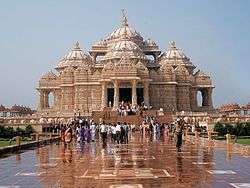
Akshardham Temple in Delhi, completed in 2005 and one of the largest Hindu temples in the world.
-

Arakuzha Marth Mariam Syro-Malabar Church in Kerala, founded in 999 is a Saint Thomas Christian church.
-

Charminar at Old City in Hyderabad
See also
| Wikimedia Commons has media related to Architecture of India. |
Notes
- 1 2 3 See Raj Jadhav, pp. 7–13 in Modern Traditions: Contemporary Architecture in India.
- 1 2 Encyclopædia Britannica (2008), Pagoda.
- 1 2 3 4 5 6 Chandra (2008)
- ↑ Encyclopædia Britannica (2008), torii
- ↑ Japanese Architecture and Art Net Users System (2001), torii.
- 1 2 Livingston & Beach, xxiii
- 1 2 Livingstone & Beach, 19
- ↑ Piercey & Scarborough (2008)
- ↑ See Stanley Finger (2001), Origins of Neuroscience: A History of Explorations Into Brain Function, Oxford University Press, p. 12, ISBN 0-19-514694-8.
- ↑ Encyclopædia Britannica (2008), education, history of.
- ↑ Encyclopædia Britannica (2008), South Indian temple architecture.
- ↑ The sculpture of early medieval Rajasthan By Cynthia Packert Atherton
- ↑ Beginnings of Medieval Idiom c. A.D. 900–1000 by George Michell
- ↑ The legacy of G.S. Ghurye: a centennial festschrift By Govind Sadashiv Ghurye, A. R. Momin, p-205
- 1 2 Encyclopædia Britannica (2008), North Indian temple architecture.
- ↑ Moffett et al., 75
- ↑ See Percy Brown in Sūryanātha Kāmat's A concise history of Karnataka: from pre-historic times to the present, p. 132.
- ↑ See Carla Sinopoli, Echoes of Empire: Vijayanagara and Historical Memory, Vijayanagara as Historical Memory, p. 26.
- ↑ See Carla Sinopoli, The Political Economy of Craft Production: Crafting Empire in South India, C. 1350–1650, p. 209.
- ↑ See Percy Brown in Sūryanātha Kāmat's A concise history of Karnataka: from pre-historic times to the present, p. 182.
- ↑ MSN Encarta (2008), Hoysala_Dynasty. Archived 2009-10-31.
- ↑ See Percy Brown in Sūryanātha Kāmat's A concise history of Karnataka: from pre-historic times to the present, p. 134.
- ↑ The Hindu (2004), Belur for World Heritage Status.
- ↑ Foekema, 16
- 1 2 Encyclopædia Britannica (2008), Mughal architecture.
- 1 2 Lach, 57–62
- ↑ Thapar 2004, p. 122.
- ↑ Nilsson 1968, p. 9.
- 1 2 3 4 5 "(Brief) History of European – Asian trade". European Exploration. Retrieved 14 October 2011.
- ↑ Jaffar 1936, p. 230.
- ↑ Tadgell 1990, p. 14.
- ↑ Thapar 2004, p. 125.
- ↑ Evenson 1989, p. 2.
- ↑ Evenson 1989, p. 6.
- ↑ Evenson 1989, p. 20.
- ↑ Dutta, Arindam (29 March 2010). "Representing Calcutta: Modernity, Nationalism and the Colonial Uncanny". Journal of Architectural Education. 63 (2): 167–169. doi:10.1111/j.1531-314X.2010.01082.x.
- ↑ Nilsson 1968, pp. 66–67.
- ↑ Thapar 2004, p. 129.
- ↑ Nilsson 1968, pp. 94–97.
- ↑ Wild, Anthony (2000). The East India Company: Trade and Conquest from 1600. New York: The Lyons Press. pp. 32, 45, 74, 88, 89. ISBN 1-58574-059-4.
- ↑ Thapar 2004, p. 124.
- ↑ Mankekar 2004, p. 99.
- ↑ Mankekar 2004, p. 17.
- ↑ See Raj Jadhav, p. 11 in Modern Traditions: Contemporary Architecture in India.
- 1 2 Gast, 77
- ↑ Gast, 119
- 1 2 3 See Raj Jadhav, 13 in Modern Traditions: Contemporary Architecture in India.
- ↑ Savage 2008
- ↑ Thomas George Percival Spear; Margaret Spear, India remembered, Orient Longman, 1981, ISBN 978-0-86131-265-8,
... The bungalow was a typical north Indian one, with a large central room lit only by skylights (roshandans) and a number of others opening out from them ...
- ↑ Pavan K. Varma, Sondeep Shankar, Mansions at dusk: the havelis of old Delhi, Spantech Publishers, 1992, ISBN 978-81-85215-14-3,
... Thirdly, while obviating direct sunlight, it had to allow some light and air to enter through overhead roshandans ...
References
- Vastu-Silpa Kosha, Encyclopedia of Hindu Temple architecture and Vastu/S.K.Ramachandara Rao, Delhi, Devine Books, (Lala Murari Lal Chharia Oriental series) ISBN 978-93-81218-51-8 (Set)
- Chandra, Pramod (2008), South Asian arts, Encyclopædia Britannica.
- Evenson, Norma (1989). The Indian Metropolis. New Haven and London: Yale University press. ISBN 0-300-04333-3.
- Foekema, Gerard (1996), A Complete Guide to Hoysaḷa Temples, Abhinav Publications, ISBN 81-7017-345-0.
- Gast, Klaus-Peter (2007), Modern Traditions: Contemporary Architecture in India, Birkhäuser, ISBN 978-3-7643-7754-0.
- Jaffar, S.M (1936). The Mughal Empire From Babar To Aurangzeb. Peshawar City: Muhammad Sadiq Khan. OU_1 60252.
- Lach, Donald F. (1993), Asia in the Making of Europe (vol. 2), University of Chicago Press, ISBN 0-226-46730-9.
- Livingston, Morna & Beach, Milo (2002), Steps to Water: The Ancient Stepwells of India, Princeton Architectural Press, ISBN 1-56898-324-7.
- Mankekar, Kamla (2004). Temples of Goa. India: Ministry of Information and Broadcasting, Govt. of Ind. ISBN 978-81-2301161-5.
- Moffett, Marion; Fazio, Michael W.; Wodehouse Lawrence (2003), A World History of Architecture, McGraw-Hill Professional, ISBN 0-07-141751-6.
- Nilsson, Sten (1968). European Architecture in India 1750 – 1850. London: Faber and Faber. ISBN 0-571-08225-4.
- Piercey, W. Douglas & Scarborough, Harold (2008), hospital, Encyclopædia Britannica.
- Possehl, Gregory L. (1996), "Mehrgarh", Oxford Companion to Archaeology edited by Brian Fagan, Oxford University Press.
- Rodda & Ubertini (2004), The Basis of Civilization-Water Science?, International Association of Hydrological Science, ISBN 1-901502-57-0.
- Savage, George (2008), interior design, Encyclopædia Britannica.
- Sinopoli, Carla M. (2003), The Political Economy of Craft Production: Crafting Empire in South India, C. 1350–1650, Cambridge University Press, ISBN 0-521-82613-6.
- Sinopoli, Carla M. (2003), "Echoes of Empire: Vijayanagara and Historical Memory, Vijayanagara as Historical Memory", Archaeologies of memory edited by Ruth M. Van Dyke & Susan E. Alcock, Blackwell Publishing, ISBN 0-631-23585-X.
- Singh, Vijay P. & Yadava, R. N. (2003), Water Resources System Operation: Proceedings of the International Conference on Water and Environment, Allied Publishers, ISBN 81-7764-548-X.
- Tadgell, Christopher (1990). The history of architecture in India : from the dawn of civilization to the end of the Raj. London: Architecture Design and Technology Press. ISBN 1-85454-350-4.
- Teresi, Dick (2002), Lost Discoveries: The Ancient Roots of Modern Science—from the Babylonians to the Maya, Simon & Schuster, ISBN 0-684-83718-8.
- Thapar, Bindia (2004). Introduction to Indian Architecture. Singapore: Periplus Editions. ISBN 0-7946-0011-5.
Further reading
- Havell, E.B. (1913). Indian Architecture, its psychology, structure, and history from the first Muhammadan invasion to the present day. J. Murray, London.
- Coomaraswamy, Ananda K. (1914). Viśvakarmā ; examples of Indian architecture, sculpture, painting, handicraft. London.
- Havell, E. B. (1915). The Ancient and Medieval Architecture of India: a study of Indo-Aryan civilisation. John Murray, London.
- Fletcher, Banister; Cruickshank, Dan, Sir Banister Fletcher's a History of Architecture, Architectural Press, 20th edition, 1996 (first published 1896). ISBN 0-7506-2267-9. Cf. Part Four, Chapter 26.
External links
- Kamiya, Taeko, The Architecture of India.
- Indian Architecture on Architecture News Plus.
- India History: Architecture & Culture





